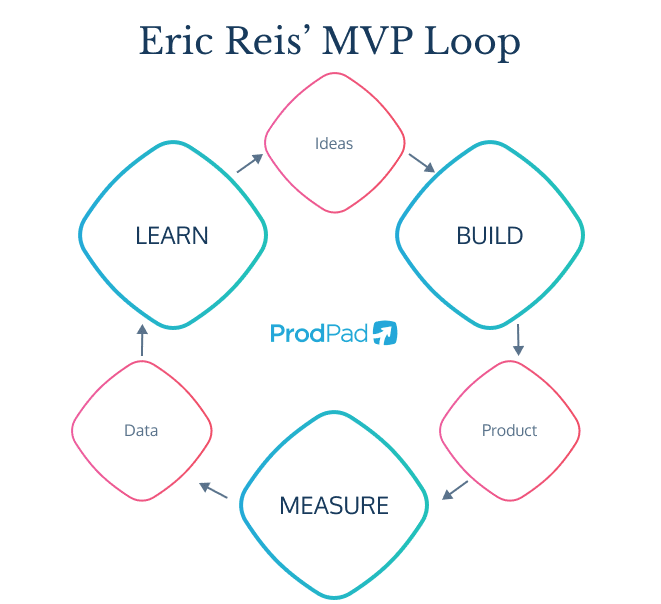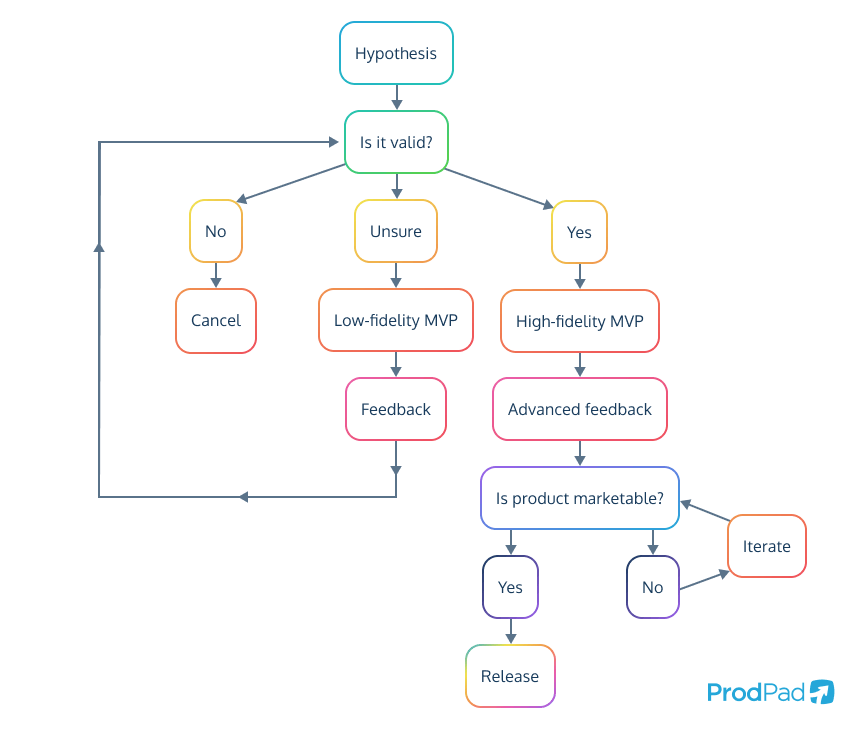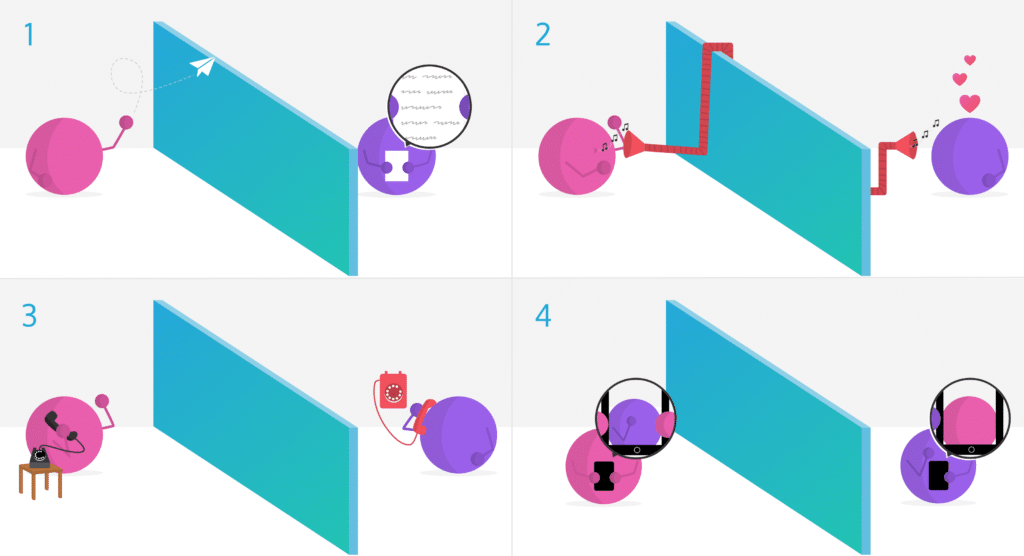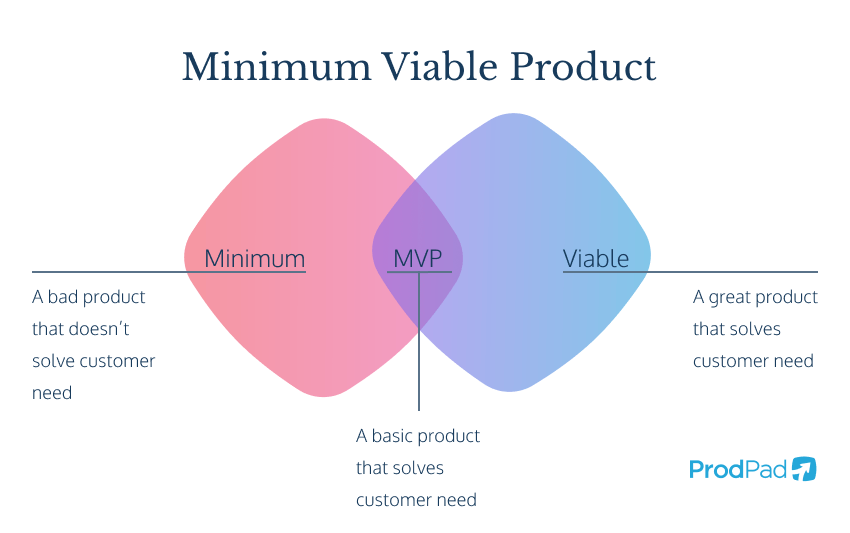Minimum Viable Product (MVP)
An MVP, or minimum viable product, is a minimal version of the final product with only the basic features needed to test your product hypothesis and see if there’s demand in the market. If you have an idea for a new product, but don’t know where to start or how much it will cost to get off the ground, then developing an MVP might be the ideal solution.
The main benefits of the MVP approach are that MVPs are inexpensive to produce, helping you to reduce your chances of failure by testing different ideas before investing more time and resources into developing one marketable product. MVPs also enable you to make changes quickly and experiment with different approaches because they are so cheap to create.
What is a minimum viable product (MVP)?
Essentially, a minimum viable product (MVP) is a product that has only the bare minimum features needed to test a hypothesis. The purpose of an MVP is not to be perfect; rather, it’s a simple product designed specifically with research in mind, so you can learn from real users as quickly and cheaply as possible.
For example, if the plan is to create a mobile app for dog owners and you want to determine if there’s demand for it before investing in development, then your MVP could just offer some basic information about dogs on your website or through an email newsletter — you don’t need to build out anything more than this initially.
The MVP development process was popularised by Eric Ries in his book The Lean Startup, and has since been a highly successful approach for a number of companies, including Uber, Facebook, Groupon, Dropbox, Buffer, and many more (including ProdPad).

What is an example of a minimal viable product (MVP)?
There are two groups of MVPs: low-fidelity and high-fidelity. A low-fidelity MVP can establish that there is a need and a desire for your product and then can be followed by a high-fidelity one that provides more detailed and nuanced user feedback.
Which one is right for your team depends on what you hope to learn from the process, what your desired outcome is, and what stage of the development process your product has reached.
Don’t forget, the term ‘product’ is quite a loose definition. After all, an MVP is never something a self-respecting product manager would release as a marketable product. Even so, an MVP is a product in the sense that it fulfills a need or desire.

Low-fidelity MVPs
Low-fidelity MVPs are simple, easy to produce, and so provide some low-cost insights about your future product and target users, as well as being relatively painless to abandon if your hypothesis turns out to not be valid.
Characteristics of low-fidelity MVPs:
- Are very cheap to make and simple to implement
- Establish if there is consumer interest in solving the problem you’ve targeted
- Allow for experimentation and iteration on a simple concept
- Are an excellent source of early customer feedback
Examples of successful low-fidelity MVPs
There are many types of low-fidelity MVPs out there, and some of the more notable examples are listed below, along with successful tech companies that have followed that approach.
1. Landing page MVP – Buffer
Some don’t even have the core functionality in place before they are put before their potential audience. The level of engagement will give you valuable insights into the demand for your product.
For example, your MVP approach could just be a website consisting of two pages, an approach that worked for the social media scheduling tool Buffer. They made one page that listed the features with a CTA button leading to a second page explaining that the product is still in development, with a newsletter sign-up link.
2. Explainer video MVP – Dropbox
You could even just make a video that describes your future product and demonstrates how the core features and user experience will work once it has been developed. You don’t even need to make a working product at all with this approach, just a clear demonstration of the user flow and the product vision.
This was the MVP strategy adopted by Dropbox when their founder uploaded this video to YouTube, and it was incredibly successful for them. They managed to increase their beta sign-ups from 5,000 to 75,000 virtually overnight, on the strength of a video alone.
3. Blog MVP – HubSpot
Simple to set up, and effective at both building a community and establishing future marketing channels, starting a blog worked well for HubSpot. They began with the idea that there was a desire for marketing and sales knowledge, then wrote and published a large amount of content to get the ball rolling.
Once they had validated their hypothesis with their blog, they quickly began to develop a suite of software tools that have resulted in a yearly revenue of over $1.7 billion.
High-fidelity MVPs
High-fidelity MVPs are, as the name suggests, closer to the intended final product. They can take more resources and effort to create, but they can also provide you with more accurate customer feedback. They can be particularly useful for complex products or those with a high degree of user interaction, as they allow designers and developers to test different scenarios and interactions in a controlled environment.
Because they generally require more resources than low-fidelity MVPs, they might not be the best starting place for your product if you’re still trying to establish your market fit and general hypothesis. However, if you are planning more advanced testing and user validation, they can be a very useful step toward your final product.
Characteristics of high-fidelity MVPs:
- help to establish how much potential users will pay for your product
- can be used to gather early adopters and build a community around the product
- can provide more detailed feedback
- help to refine your marketing approach, and strategies for growth
- are closer to the final product in terms of functionality and user experience

Examples of successful high-fidelity MVPs
Requiring more time, money, and development, high-fidelity MVPs have still been a successful tactic for a number of famous businesses. Some of the best examples are included below.
1. “Wizard of Oz” MVP – Zappos
As the name implies, this form of MVP presents itself as a fully automated and functional product, while behind the scenes people are actually performing the functions that the product will eventually provide. One of the most well-known examples is Zappos, an early online shoe store called shoesite.com, which began in 1999 as a simple site populated with photos of shoes taken at local shops.
When a customer placed an order on the website, he would go to the shops, personally buy the shoes, and mail them. He had no infrastructure, inventory, or staff, and yet from this simple beginning, it evolved into Zappos, one of the most popular shoe retailers online at the time, and was purchased by Amazon 10 years later for nearly $900 million worth of shares.
2. Single feature MVP – Facebook
Wikipedia will tell you that an MVP is defined as having just enough features to be usable by a customer, but this isn’t the case for all MVPs. However, this approach worked for Facebook, where they built a simple message board that was initially limited to students at Harvard University.
Once they had established there was a demand for the product, they started opening it up to larger and larger circles and adding features that their customer feedback had indicated there was a demand for.
3. Crowdfunding MVP – Cloud Imperium Games
By opening up your future product for crowdfunding, you can acquire funding to create your product, while also building your community and gathering valuable feedback about what they would like to see included in the final product.
This approach was incredibly successful for Cloud Imperium Games, creators of the sci-fi computer game Star Citizen. By the end of the original campaign in 2012, they had raised $6.2 million in funding for a product that didn’t exist yet. In the 10 years after their crowdfunding campaign began on Kickstarter and their own website, they raised over $500 million from backers.
What is the point of a Minimum Viable Product?
The purpose of an MVP isn’t to generate revenue for your business. Rather, an MVP is a tool in an experiment so you have something tangible to show people in order to get their feedback on your product ideas.
It’s used to test responses from potential customers and make adjustments before committing to costly production. This concept has been applied to both software development and hardware development, but it can also apply to other areas such as service design or marketing strategies.

What are the benefits of building a Minimum Viable Product?
1. It’s a great way to get feedback from your target audience
You can use your MVP to get your product ideas in front of potential customers and get a real sense of whether you’re on to something, or need to iterate. You’ll soon discover if you’ve overlooked something critical or made bad assumptions, as an MVP is a fantastic source of early customer feedback.
An MVP is a good way to get valuable feedback from users on your product idea before you invest too much time and money into the product development process. When it comes down to it, the only thing that matters is whether people find value in what you’ve created or not—not how long you spent creating it.
If they don’t like your product (or prototype), your development team can do multiple product iterations until they do.
2. You can make swift changes based on user behavior and feedback
One of the main advantages of a minimum viable product (MVP) is that they are designed to be flexible and easy to change, or simple enough to be painlessly disposable, allowing you to start afresh as you learn.
MVPs are a great way to test your assumptions about both your core functionality and your target audience. If you’re not getting the user feedback you were expecting, just make a few tweaks and retry your testing with a new MVP.
By using an iterative approach like this one, you’ll be able to validate or invalidate certain features of your product quickly without having sunk too much time into it in the first place.
3. You reduce your chance of failure with an MVP
A good product manager will always look for ways to minimize risks, and one of the best ways to do that is with an MVP.
Chances are, the first idea that pops into your head isn’t going to be the best possible version of it. In fact, there’s a good chance that most of your ideas are destined to fail. Testing with MVPs allows you to weed out the bad ideas from the good ones so that you don’t launch product ideas that fall flat.
Don’t launch products that are doomed to fail. Instead, test your ideas at the MVP stage, and then tweak from there based on the data you collect during your discovery phase. You can use a simple set of core features to determine if there is a market need for your product.
4. You’ll save money making an MVP
Building the wrong thing is expensive. By investing a small amount of time and effort into minimum viable product (MVP) development, you prevent the risk of wasting more expensive development time down the line by determining if there is a Product-Market Fit.
There has never been a more competitive time in the market for software products, and it’s more important than ever to get Product-Market Fit right. It can be costly and time-consuming to build a solution that doesn’t solve customer problems, is too complex for your customers to use, or doesn’t provide the core functionality that they expect.
Investing in an MVP will help you test out whether or not the final product you’re building solves a genuine problem people have, before potentially wasting your product team’s resources on time-consuming development work.
Further reading
While product managers will find the MVP approach a valuable part of their software development toolkit, that’s far from the only use. Check out our co-founder Janna’s blog for a practical example of how ProdPad has used the MVP process to launch our free booklet, The Handy Guide for Product People.